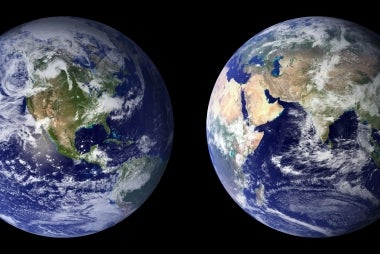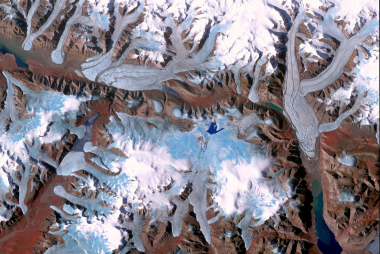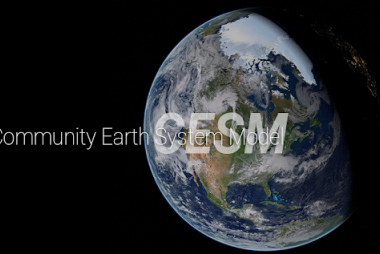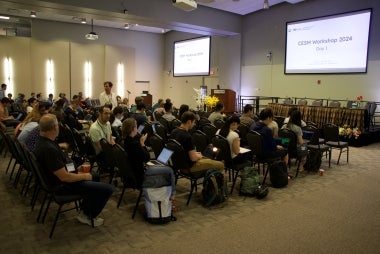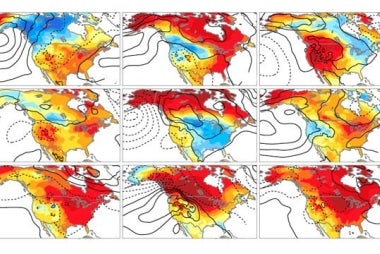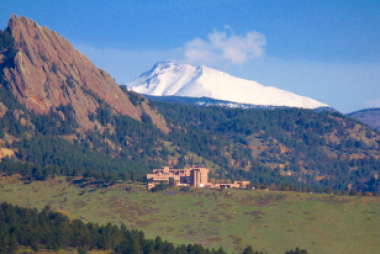September 2025 Newsletter Issue
Welcome to the Community Earth System Model (CESM) Newsletter. Want to receive our next newsletter in your inbox? Visit our newsletter page to subscribe and never miss a newsletter.
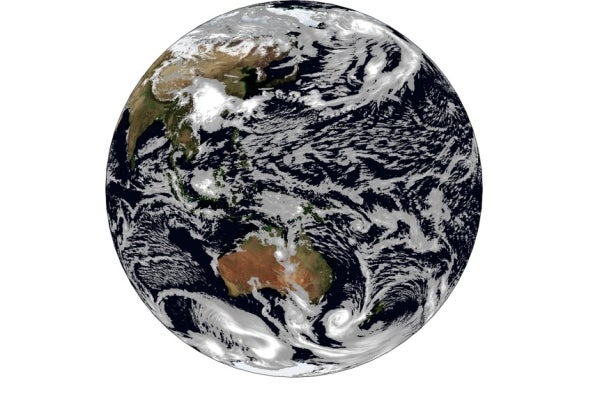
Caption
A snapshot of the condensed water simulated on a 7.5-km grid. The simulation was performed by Brian Dobbins of NSF NCAR. |
In this Newsletter:
Water Isotopes and Water Tracking Are Returning to CESM
30th Annual CESM Workshop Summary
30th Annual CESM Workshop Celebration
Arctic Sea Ice loss slowdown anticipated by CESM
CESM Winter Working Group Meeting Dates
Research Highlights from Our Community
Save the Date for the 2026 CESM Workshop
Chief Scientist Message
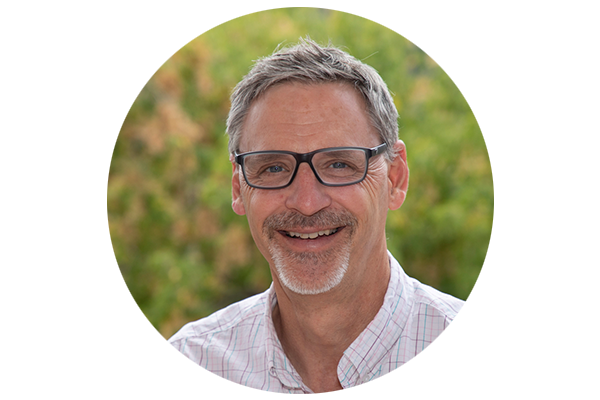
|
Dear colleagues,
It’s been a fruitful and busy summer for CESM with the 30th Annual CESM Workshop, the CESM Tutorial, and continued progress towards finalizing CESM3. The summer is also peak visitor season, and, as per usual, NSF NCAR hosted many visitors who brought their ideas and enthusiasm to the CESM activity. A highlight of the summer for me was the 30th Anniversary Workshop celebration. It was a great opportunity to recognize Warren Washington’s pioneering impact on climate modeling and to reflect on how far the CESM activity has come since the first CSM coupled climate model simulations were produced roughly 30 years ago. Having all of the former CESM Chief Scientists in attendance and hearing their funny and heartwarming stories about their time as Chief Scientist, as well as their perspectives about the role and future of CESM in Earth system science, was inspiring. What came through clearly to me was how much being a part of the CESM activity meant to them, even in some cases after many years away. After the event, many people came up to me to express how much they appreciated the opportunity to reflect on the impact of all the hard work over many years by so many people to build and sustain a CESM framework and community to be proud of.
Now, we continue with that hard work and are resolutely pushing to finalize CESM3. CESM3 will represent a state-of-the-art understanding of the Earth system and will provide the foundation for many research and development activities, including high-resolution coupled configurations, a machine learning enhanced model version, and a sustainable implementation of coupled water isotopes and water tracking. More information on some of these activities is included in this newsletter. And, hopefully by the time of the next CESM newsletter, we will have a CESM3 release date to share.
Water Isotopes and Water Tracking are Returning to CESM
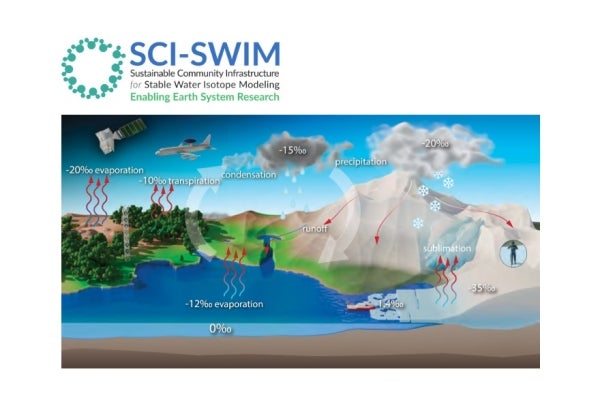
Caption
Top: logo of the SCI-SWIM project. Bottom: schematic illustration of water isotope ratios in the global water cycle. The diagram highlights the distinct isotopic signatures of various water reservoirs and species, including oceans, rivers, atmospheric water, snow, ice, and more. Extensive isotope measurements, including those data from ongoing flight and ship campaigns, satellite observations, and ice core drilling, are providing new insights into water cycle processes. The values in the plot represent the typical H218O ratios in per mil (‰) relative to Vienna Standard Mean Ocean Water (VSMOW). |
We are excited to announce that the water isotope and water tracking capabilities are coming back to CESM, supported by a collaborative grant from the NSF Cyberinfrastructure for Sustained Scientific Innovation (CSSI) program. The SCI-SWIM project (Sustainable Community Infrastructure for Stable Water Isotope Modeling Enabling Earth System Research) will deliver a modernized, next-generation isotope-enabled CESM version 3 (iCESM3) to the scientific community.
The new iCESM will include comprehensive modeling of the isotopic water cycle (H218O, HDO, H217O, and more) across the Earth system, along with powerful water-tracking functionality in multiple components. Water isotope ratios (e.g., H218O relative to the regular H216O) act as distinctive "fingerprints" that reveal water sources, convection patterns, and transport histories-offering critical insights that complement traditional measurements like humidity and precipitation data. iCESM will enable researchers to gain a deeper understanding of hydrological processes through enabling direct comparisons with the expanding collection of water isotope observations from field campaigns, satellite data, expeditions, flux tower networks, and paleoclimate records.
The previous version of iCESM (iCESM1) has already demonstrated its scientific value through pivotal contributions to climate research, including the Water-isotope enabled Last Millennium Ensemble (iLME) and the Water-isotope enabled Transient Climate Experiment (iTraCE) projects and numerous other studies featured on the CESM Paleoclimate Working Group website. However, technical constraints had limited isotope functionality to the CESM1 codebase, preventing its integration with CESM2 and the upcoming CESM3. SCI-SWIM addresses these limitations by implementing modern, sustainable software engineering practices that will make isotope modeling more maintainable, extensible, and accessible to the broader research community. SCI-SWIM will also incorporate water isotopes into the Community Ice Sheet Model (CISM), enabling entirely new avenues of scientific investigation.
The project is led by PIs Sylvia Dee (Rice University), Jiang Zhu (NSF NCAR), Peter Hjort Lauritzen (NSF NCAR), and Will Wieder (NSF NCAR). Implementation and validation will be carried out by software engineers William Sacks, Jesse Nusbaumer, and collaborators. The project spans 2025–2030, with the final two years dedicated to comprehensive validation and refinement. The effort will culminate in three flagship research applications demonstrating iCESM’s capabilities across atmospheric, terrestrial, and cryospheric systems.
We welcome your suggestions, feedback, and participation in this effort. Please feel free to reach out to any member of the team to learn more.
30th Annual CESM Workshop Summary
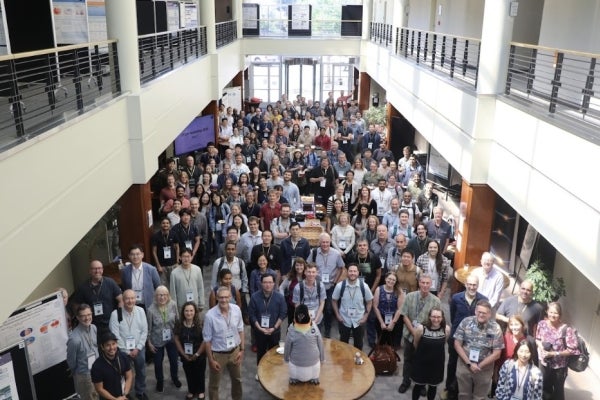
Caption
Group Photo from the CESM Workshop |
The CESM community came together for an exciting and inspiring three-day event celebrating 30 years of collaborative Earth system science. With over 500 attendees joining both in person and virtually, the workshop featured engaging plenary talks, vibrant working group sessions, and special anniversary celebrations.
Day 1 kicked off with keynote talks from Dr. Hansi Singh, Dr. Paula Buchanan, and Dr. Michael Barton, highlighting the intersection of Earth system science, communication, and human systems.
Ping Chang from Texas A&M University received the 2025 CESM Distinguished Achievement Award for his leadership in advancing high-resolution Earth system modeling with CESM. Ping led groundbreaking efforts to develop and apply CESM's high-resolution capabilities, particularly through the creation of the International Laboratory for High-Resolution Earth System Prediction (iHESP), now the MESACLIP project. His work has resulted in the largest ever comprehensive suite of global climate simulations capable of resolving tropical cyclones and ocean mesoscale eddies. The MESACLIP simulations are transforming climate research, enabling novel insights into extreme weather events, climate predictability at seasonal-to-decadal scales, and long-term climate projections. His work has helped establish CESM as a leader in high-resolution modeling with profound national and international impacts across research, policy, and other stakeholder realms. Congratulations to Ping for this well-deserved achievement!
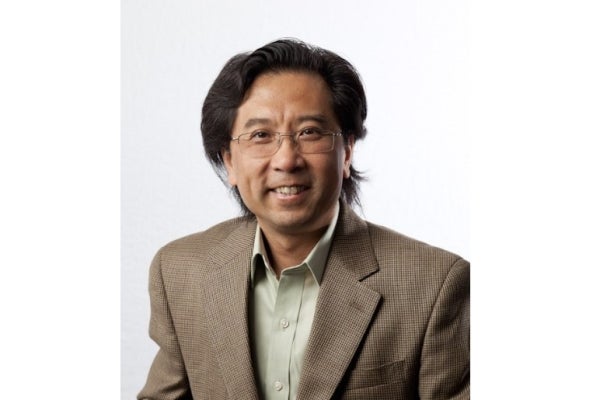
Caption
Dr. Ping Chang |
Giovanni Seijo-Ellis and Jonah Shaw were this year's CESM Graduate Student Award winners. Giovanni was recognized for his contribution to the development and application of regional ocean configurations of CESM-MOM6. Jonah was recognized for his novel work on the climate impacts of mixed-phase clouds in the Arctic, on the seasonality of the emergence of a human-caused longwave radiation signal, and implementation of a satellite simulator in CAM to enable direct radiation to satellite observation-model comparisons. Congratulations to Jonah and Giovanni!
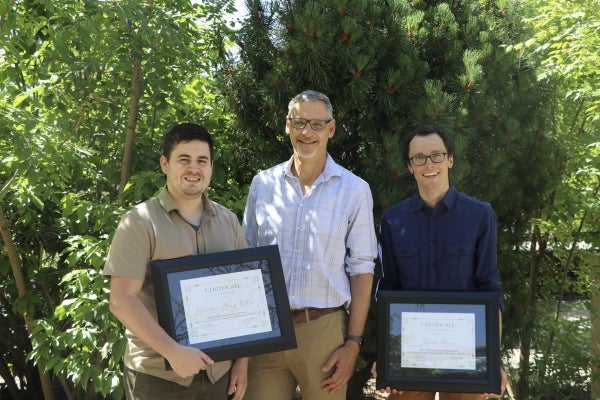
Caption
Giovanni Seijo-Ellis, David Lawrence, and Jonah Shaw |
Day 2 featured seven dynamic working group sessions filled with insightful discussion and collaboration. The day concluded with a special event honoring the 30th Anniversary of CESM.
Day 3 focused on cross-cutting topics, including machine learning, high-resolution modeling, Earth system predictability, and paleoclimate. The final plenary and wrap-up discussion closed the workshop on a high note of shared vision and enthusiasm.
Resources, including session recordings, slides, photos, and posters, are available online:
-YouTube Recordings
-Workshop Materials & Poster Gallery
30th Annual CESM Workshop Celebration
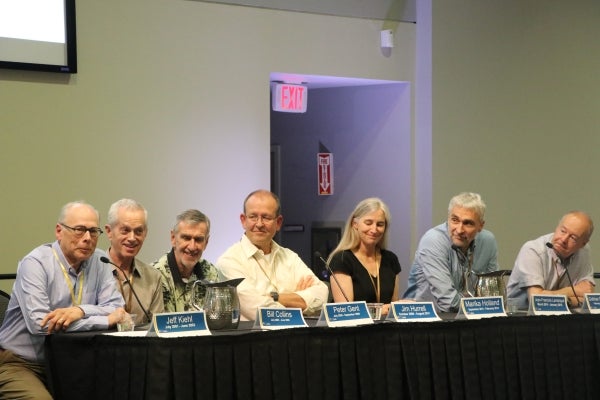
Caption
Panel of Past CESM Chief Scientists: Jeff Kiehl, Bill Collins, Peter Gent, Jim Hurrell, Marika Holland, Jean-Francois Lamarque, and Gokhan Danabasoglu |
The 30th Annual CESM Workshop Celebration was a fun-filled afternoon packed with:
- A tribute to Warren Washington’s pioneering contributions to Earth system modeling, presented by Jerry Meehl
- A historical look at the CSM1 300-Year Run, shared by Peter Gent
- A Day in the Life of a CESM Developer, presented by Cheryl Craig
- A roundtable discussion with former CESM Chief Scientists reflecting on the program’s evolution and impact
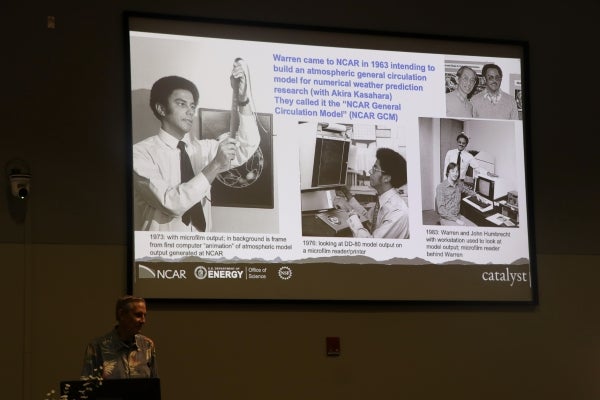
Caption
Jerry Meehl Honoring Warren Washington |
We were also proud to recognize Cécile Hannay with the Outstanding CESM Community Service Award for her exceptional contributions to the CESM community through her passionate work on community tutorials, coupled model development, and all things CESM!
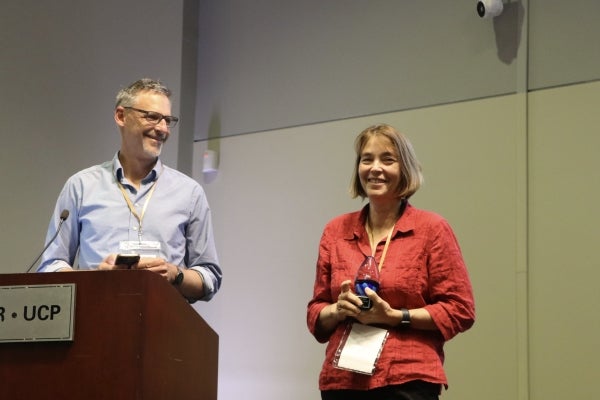
Caption
Cecile Hannay receiving her Award |
Missed the celebration? You can watch the full event on YouTube. Cheers to 30 years!
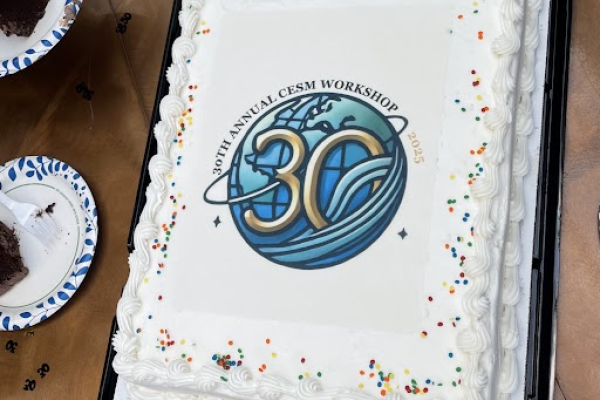
|
CESM Impact Survey
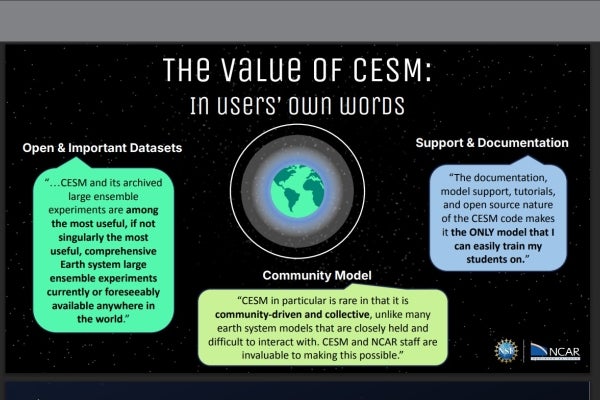
|
As we celebrated the 30 year anniversary of CESM, we took the opportunity to reflect on the value of the CESM activity, which includes the model, data, and support that is provided for its use, through a "Impacts of CESM" survey. We are especially interested in how the CESM activity supports a range of users and stakeholders and how it is delivering impact both in terms of science and societally beneficial applications, nationally and internationally. This information will allow us to identify development priorities and will provide examples and testimonials that can be used to convey its value. We have conducted an initial synthesis of the survey results and have summarized them here. The survey remains open, so please fill it out if you are interested.
CESM Tutorial Summary
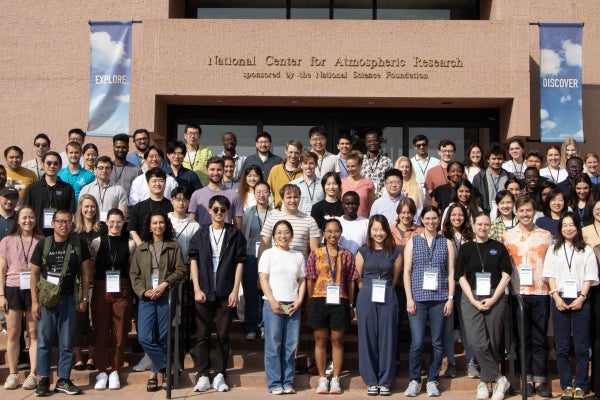
Caption
CESM Tutorial Participants |
We extend our sincere thanks to everyone who contributed to making this year’s event such a success, from the dedicated NSF NCAR staff to the enthusiastic participants who joined us in Boulder, Colorado.
This year’s tutorial offered a comprehensive and engaging introduction to Earth system modeling using the Community Earth System Model (CESM). Attendees participated in a dynamic program that included expert-led lectures, interactive hands-on labs, small group discussions with CESM scientists, and valuable opportunities for student networking and collaboration.
If you weren’t able to attend a lecture or would like to revisit one, you can find recordings available on our YouTube channel.
To learn more about the CESM Tutorial, including future opportunities and resources, please visit our website.
CESM Community Activity
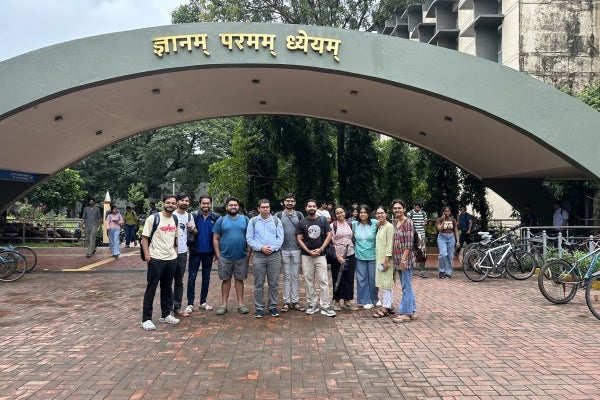
Caption
Credit - Students at IIT Bombay |
During the Summer of 2025, Sanjiv Kumar, a professor at Auburn University, visited IIT Bombay, India. There, he organized a 10-day CESM workshop focusing on land-atmosphere interaction processes. Fifteen + Ph.D. students affiliated with the Center for Climate Studies program attended the workshop. NCAR CISL provided computing resources. Students were very happy to learn and perform their first climate simulations using CESM. A combination of theory and afternoon lab exercises enabled them to grasp the fundamental underpinnings as well as gain technical experience in designing and performing hypothesis-driven climate modeling experiments.
Special thanks to NCAR CISL! Their support was a necessary ingredient for this workshop. Thanks to Dr. Subimal Ghosh, Head of the Center for Climate Studies, for hosting us at IIT Bombay.
Arctic Sea Ice loss slowdown anticipated by CESM
After an extended period of substantial Arctic sea ice loss, the pace of Arctic sea ice loss has slowed to almost zero over the last 20 years. A recent paper (England et al., 2025) and associated Carbon Brief blog post by Mark England and colleagues explored the reasons for this slowdown in sea ice loss. The paper notes that Kay et al., (2011) was among the first to demonstrate, with CCSM4 simulations, that internal climate variability can counteract the forced loss of Arctic sea ice on decadal timescales, resulting in periods of simulated sea ice growth even under increasing anthropogenic emissions. In the blog post, Mark also highlights that CESM1 Decadal Prediction simulations (Yeager et al., 2015) were "remarkably prescient in suggesting such a slowdown could occur." Work is underway to evaluate Arctic sea ice loss projections in the CESM2 SMYLE dataset to see what CESM predicts we may see in terms of sea ice loss in the near future.
Visitors working with CESM at NSF NCAR
Interested in collaborating on CESM at the Mesa Lab?
CGD maintains creative collaboration mechanisms to leverage scientific contributions from throughout the NCAR program as well as from external university partners. The CGD scientific visitor program nurtures and maintains long-term scientific interactions with university and national laboratory collaborators. CGD's visitor program provides the opportunity for long-term scientific visits, along with investment in local infrastructure support to ensure collaborators can make the most productive use of their time. To date this year, we have hosted over 115 visitors at all career stages including undergraduate students (16), graduate students (28), postdocs (16), early career scientists (18), mid career scientists (26), and late career scientists (11).
Some Visitors who came to the Mesa Lab this summer to work on CESM:
- Jacob Cohen - CESM SMYLE predictions of Arctic sea ice
- Weimin Si - Miocene Climatic Optimum leveraging isotope-enabled CESM simulations and proxy observations
- Abigail Bodner - parameterizations of mixed-layer eddies within CESM/MOM6
- Kazuhiro Misumi - CESM ocean biogeochemistry model development
- Gunilla Svensson - atmospheric boundary layer processes in CESM
- Julien Savre - Developing hybrid ML Earth System Modeling frameworks (ICON-XPP-MLe & CESM3-MLe).
- Momme Hell - Julia-based wave models in CESM
- Chandler Morris - CESM and seawater isotope data
- Anya Lee - CESM3 simulations - ocean stochastic physics
- Qigang Wu - Antarctic and Arctic sea ice variability using CESM2 large ensemble.
Want to learn more? Check out our Visitor Page.
CESM Winter Working Group Meeting Dates
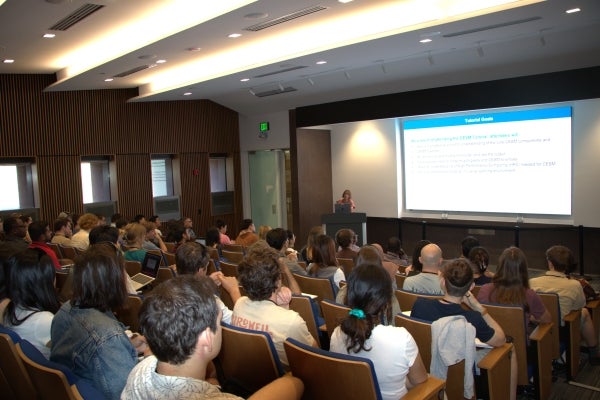
Caption
CESM Tutorial Lecture |
Curious about the CESM Winter Working Group Meeting Dates? You’ll find the details listed below. Be sure to visit our Winter Working Group Page for additional updates and information!
AMWG, WAWG, CVCWG, ESPWG, Chem Climate: February 2nd, 3rd, and 4th
Polar Climate and Ocean Model: February 5th and 6th
Paleoclimate and Land Ice: February 10th, 11th, and 12th
Land Model and BGC: February 24th, 25th, and 26th
Software Engineering: March 5th and 6th
Research Highlights from Our Community
![Meeker et al. [2025], Figure 1 (modified)](/sites/default/files/styles/email_html/public/2025-09/screenshot-2025-09-08-120154.jpg?itok=A3BIr2Cx)
Caption
Red areas on the maps indicate where sea surface temperature can be skillfully predicted one, three, six, and twelve months in advance using the Seasonal to Multi Year Large Ensemble (SMYLE). Credit: Meeker et al. [2025], Figure 1 (modified) |
One-at-a-Time Parameter Perturbation Ensemble of the Community Land Model, Version 5.1
D. Kennedy, K. Dagon, D. M. Lawrence, R. A. Fisher, B. M. Sanderson, N. Collier, F. M. Hoffman, C. D. Koven, E. Kluzek, S. Levis, X. Lu, K. W. Oleson, C. M. Zarakas, Y. Cheng …
Comprehensive land models are subject to significant parametric uncertainty, which can be hard to quantify due to the large number of parameters and high model computational costs. We constructed a large parameter perturbation ensemble (PPE) for the Community Land Model version 5.1 with biogeochemistry configuration (CLM5.1-BGC). We performed more than 2,000 simulations perturbing 211 parameters across six forcing scenarios. This provides an expansive data set, which can be used to identify the most influential parameters on a wide range of output variables globally, by biome, or by plant functional type. We found that parameter effects can exceed scenario effects and that a small number of parameters explains a large fraction of variance across our ensemble. The most important parameters can differ regionally and also based on the forcing scenario. The software infrastructure developed for this experiment has greatly reduced the human and computer time needed for CLM PPEs, which can facilitate routine investigation of parameter sensitivity and uncertainty, as well as automated calibration.
Vegetation Turnovers Reduced Water Availability During the Last Icehouse
William J. Matthaeus, Sophia I. Macarewich, Isabel P. Montañez, Jon D. Richey, Joseph D. White, Jonathan P. Wilson, Jennifer C. McElwain
Plants are hypothesised to have changed in function, biogeography and environmental impact throughout the Phanerozoic. The fossil record preserves large-scale shifts in water use traits with evolution. We test how time-appropriate plants modified their environment differently based on their water use traits and where they survived during Earth's penultimate icehouse using a computer model.
Seasonality of Pacific Decadal Oscillation Prediction Skill
E. D. Meeker, E. A. Maroon, A. L. Deppenmeier, L. A. Thompson, D. J. Vimont, S. G. Yeager
This study assesses the skill of Pacific Decadal Oscillation (PDO) predictions in the CESM SMYLE system, finding predictability up to one year ahead, with skill varying by season and declining most in boreal spring. A regression analysis reveals that while initial value persistence explains much of the skill, including El Niño–Southern Oscillation (ENSO) as a predictor is essential to capture the full seasonal dependence, highlighting ENSO's strong influence on PDO prediction skill.
This study was an EOS Highlight article - "Decadal forecasts with a SMYLE"
A framework for three-dimensional dynamic modeling of mountain glaciers in the Community Ice Sheet Model (CISM v2.2)
Samar Minallah, William H. Lipscomb, Gunter Leguy, and Harry Zekollari
It is essential to improve our understanding of glaciers and their effects on sea levels, ecosystems, and freshwater resources in a changing climate. To this end, we implemented a framework for three-dimensional, high-resolution, regional-scale glacier simulations in the Community Ice Sheet Model (CISM v2.2), using higher-order ice-flow dynamics previously applied to the Greenland and Antarctic ice sheets. Here, we present the modeling framework and its application to the European Alps glaciers at a 100 m resolution, using protocols from the third phase of the Glacier Model Intercomparison Project (GlacierMIP3). The model results align with observations and other glacier models, indicating that Alpine glaciers will lose more than half their current mass if present-day climate conditions persist, with near-total loss under warmer scenarios. This new development integrates glacier and ice sheet systems in a common modeling framework and will support advances in coupled land ice–Earth system assessments across timescales in the Community Earth System Model (CESM).
The Path Toward Vertical Grid Options for the Community Atmosphere Model Version 7: The Impact of Vertical Resolution on the QBO and Tropical Waves
Isla R. Simpson, Rolando R. Garcia, Julio T. Bacmeister, Peter H. Lauritzen, Cecile Hannay, Brian Medeiros, Julie Caron, Gokhan Danabasoglu, Adam Herrington, Christiane Jablonowski, Dan Marsh, Richard B. Neale, Lorenzo M. Polvani, Jadwiga H. Richter, Nan Rosenbloom, Simone Tilmes
This study outlines the development of the vertical grid for CAM7, leading to the selection of an 80-km model top with 93 vertical levels to improve the simulation of atmospheric processes like the Quasi-Biennial Oscillation (QBO), without the need for a full 140-km top. Simulations using the CAM7 vertical grid show improved wave-driven QBO dynamics and stratospheric circulation comparable to WACCM6, though the expected QBO-Madden-Julian Oscillation connection remains unrealized.
Predictability of temperature extremes in multi-annual forecasts
Eirini E Tsartsali*, Stephen G Yeager, Panos J Athanasiadis, Stefano Tibaldi, and Silvio Gualdi
This study evaluates the ability of the Community Earth System Model–Seasonal-to-Multiyear Large Ensemble to predict global temperature extremes up to two years in advance, revealing significant predictive skill across many regions and seasons, particularly within the first forecast year. Notably, some regions maintain skill beyond seasonal timescales, even after removing external forcing, suggesting internal climate variability and phenomena like El Niño–Southern Oscillation play key roles in interannual predictability.
Save the Date for the 2026 CESM Workshop

|
The 2026 CESM Workshop will take place June 15-17, 2026. Please mark your calendar and check back to our website for more details!
Quick Links
CGD YouTube Channel
CGD Instagram
CGD LinkedIn
CGD Bluesky
CESM User Support Forum
CVCWG Simulations
Simpler Models Information
Thanks for reading this CESM Newsletter! Expect to see the next one in the Winter 2026. Please send potential Newsletter items to Elizabeth Faircloth.
